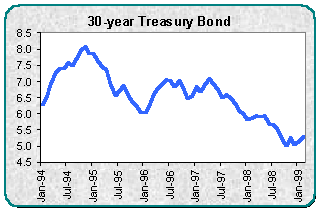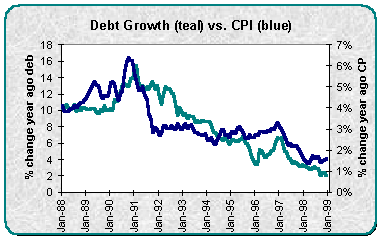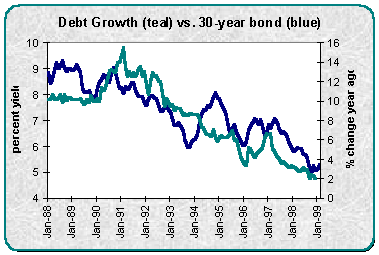Long Term Trends in Interest Rates
Evelina M. Tainer, Chief Economist

It is useful at this juncture to consider the crosscurrents in the bond market that has caused interest rates to fluctuate so sharply in the past twelve months. Will rates continue this upward trend? Will it hurt the stock market in a more dramatic fashion? Is there a ceiling for the interest rate rise? Will global issues such as economic crises in Brazil and Japan continue to affect interest rate levels in the United States? What are the implications of President Clinton's proposal for social security reform and his FY2000 budget proposal for the next few years? These questions will be answered in the paragraphs below.
First things first - social security reform finally on the table
At his State of the Union address in mid-January, President Clinton made a couple of proposals regarding social security. One, he suggested that 62 percent of the (expected) budget surplus for the next several years be directed entirely to the social security trust fund. Then he suggested that a small percentage of the trust fund be invested in the stock market. The President should be given credit for the proposals whether they are workable or not. The social security trust fund has been an issue for a long time, but politicians have not given it more than lip service - aside from the social security committees commissioned by Congress. Incidentally, Federal Reserve chairman Alan Greenspan served on one of the earlier commissions; Fed governor Ed Gramlich served on the most recent one in the 1990s.
On the day after Clinton's State of the Union, Greenspan testified before the Senate Banking Committee and took the opportunity to slam the President's proposal. He believed that it was not politically feasible and not economically efficient for the federal government to become involved in the stock market directly. He is probably right. But there is no question that the potential budget surplus of the next fifteen years will have repercussions on financial markets.
Bottom line on the President's proposal for social security reform: it isn't workable as presented. Indeed, very few details were presented. (According to former director of the Congressional Budget Office (CBO) Robert Reischauer, Clinton's proposal is "very confusing and difficult to analyze.") But no doubt it will be debated in coming months by Congress and business analysts. Republicans do favor one aspect of the President's proposal -- which is to establish IRA-type accounts that individuals would manage on their own. This means that individual investors who are currently more proactive in their own pension plans - and more knowledgeable about the financial markets -- will benefit.
Budget surpluses as far as the eye can see
During the 1980s and early 1990s, no economist or politician dared to predict that the hefty budget deficits would narrow or disappear. Yet, the federal government saw its first surplus in nearly 30 years in fiscal year 1998. As long as Congress doesn't enact any changes to current policies, federal budget surpluses are in the offing for the next 15 years. Indeed, Treasury Secretary Robert Rubin estimates that the level of the federal debt would shrink to 7 percent of GDP in 2014 - down from about 50 percent of GDP in 1992.
The federal budget benefited from a reduction in the rate of inflation as well as the decline in the overall level of interest rates. It is a circuitous route - because the reduction in the demand for government borrowing also sets the stage for lower rates and lower inflationary pressures.

The above-chart depicts the year-over-year change in the consumer price index as well as the year-over-year growth in the federal debt. The correlation is phenomenal. The slower the growth in the debt, the more inflation seems to moderate. It is possible that these two factors are not dependent on each other, but on a third factor which affects both.

The chart above compares the year-over-year change in the growth of federal debt relative to the level of interest rates. The yield on the 30-year Treasury bond is used to reflect the level of interest rates. Once again, we see that the correlation is strong since both are headed ever lower over this time period. The level of interest rates has varied more over this period than the growth in debt.
Bottom line on the debt levels and interest rates: Economists have long disputed whether government debt (borrowing) crowds out private borrowing. Most economists raised on the (ubiquitous) Paul Samuelson economics text do believe that the correlation exists. Indeed, Rubin argued that the president's budget proposal would "free up capital to the private sector and reduce interest rates…" Market players are already worried that the smaller Treasury auctions will not be enough to satisfy the demand by domestic and foreign investors. Increased demand for Treasury securities raise their price - and lower their yields.
What about those global crises?
Treasury yields first began to come down at the end of 1997 when the collapse of economies in Southeast Asia caused a flight to quality. Treasury securities have been considered a safe-haven investment given that the U.S government has never defaulted on its debt. The world has experienced quite a few financial crises since Asia (Russia, Japan, Brazil). Each time, investors flock to Treasury securities and our interest rate levels have headed lower. The devaluation of the Brazilian real and it subsequent free float was the most recent example of U.S. Treasury securities serving as a safe-haven investment.
In the past month, interest rate levels have begun to head higher for a variety of reasons - including the underlying strength of the U.S. economy. In the second week of February, bond market players became concerned that changes in Japanese monetary policy would cause capital to flow back to the Japanese equity and bond market. Japanese investors have played a major role in buying U.S. securities that goes back to the 1980s when U.S. federal budget deficits were falling deeper and deeper in the red.
Fed chairman Alan Greenspan said recently that the U.S. economy is the envy of the world. That said, it is difficult to believe that the safe-haven status of Treasury securities will diminish any time soon. Moreover, the Japanese economy has been mired in a longstanding recession during this past decade. A slight change in its monetary policy may cause the perception of bond traders to become bearish on U.S. bonds, but over time, reality exceeds the impact of perception.
Bottom line on global crisis and interest rates: It is a small world after all. Global economic and financial issues will no doubt impact interest rate levels and economic activity in the United States. But the economic impact will be long in coming and perhaps less dramatic than current concerns over it. More likely, it would cause sharp fluctuations in bond and stock prices in the short term.
Where are interest rates headed in the short term?
More than any other factors, inflation and economic growth affect the level of interest rates. The impact of these factors is compounded by actions taken by the Federal Reserve to cool expansions (if necessary) or spur activity (in recession.)
During the month of January, most reported economic indicators pointed to an economy that had been heating up in the fourth quarter of 1998 rather than winding down. Until then, economic forecasts for early 1999 centered on slower economic growth. Indeed, even Federal Reserve officials believed that economic activity would moderate in 1999. Many economists predicted that the Fed would soon ease policy and reduce the federal funds rate target by 25 or 50 basis points from its current level of 4.75 percent.
A shift in sentiment began in January that only strengthened with each economic report that showed more robust activity in the United States. By February, market participants began to worry that the Federal Reserve would begin to tighten monetary policy and raise rates. So what will happen? The most likely scenario for the next three months is - no change.
Consumer price inflation has moderated significantly in the past few years. (See the chart above with respect to debt growth.) The fact that inflation is not currently a problem is a major factor behind low interest rates and a status quo policy by the Fed.
More importantly, improving long-term trends in nonfarm productivity have gone a long way towards curtailing wage costs and price pressures. The chart below depicts year-over-year changes in the nonfarm productivity relative to unit labor costs. The productivity trends - which means that workers are producing more - are much improved in the past 20 years despite the mature phase of this expansion (when productivity tends to trail down). At the same time, unit labor costs are well contained. Just look at the difference from 20 years ago. In the eight quarters ending 1980:Q4, unit labor costs were rising about 10 percent a year. In the 8-quarters ending in the fourth quarter of 1998, unit labor costs are rising about 2 percent a year. This goes a long way in explaining inflationary pressures in the U.S. economy - and the direction of interest rates in the near term.

Bottom line on economic factors and interest rates: A robust rate of growth could lead to slight gains in interest rates, but the underlying trend of low inflation will likely put a ceiling on gains in interest rate levels in the near term.
OVERALL BOTTOM LINE FOR INVESTORS
The December Focal Point discussed the finer points of the investor-types looking for higher interest rates and those which prefer lower rates. Among investors looking to attract a high yield for higher dividends, now is a good time to keep your eyes peeled for opportunities. You must determine whether you think that rates are headed higher in the near term, or this is the right time to lock in a high yield. The cautious (and rational) approach might be to construct a ladder of securities with different maturities to reduce your risk.
Stock investors could be hurt in a rising interest rate environment for a couple of reasons. In general, rising interest rates tend to deflate the long-term value of stock prices. This means that the market in general is affected. More specifically, sectors that are interest rate sensitive tend to be hurt more by rising interest rates. For instance, this would include financial institutions and housing-related industries.
In any case, it is important to keep in mind that a small rise in interest rates might have little impact on stock prices for a robust economic picture that is coupled with improved corporate profits (another key determinant of stock prices).